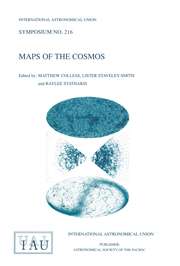Crossref Citations
This article has been cited by the following publications. This list is generated based on data provided by Crossref.
Palouš, Jan
1986.
The Role of Dust in Dense Regions of Interstellar Matter.
p.
151.
Makino, Junichiro
1996.
Postcollapse Evolution of Globular Clusters.
The Astrophysical Journal,
Vol. 471,
Issue. 2,
p.
796.
Odenkirchen, M.
Soubiran, C.
and
Colin, J.
1998.
The Coma Berenices star cluster and its moving group.
New Astronomy,
Vol. 3,
Issue. 8,
p.
583.
De Paolis, F.
Ingrosso, G.
Jetzer, Ph.
and
Roncadelli, M.
1998.
Halo Dark Clusters of Brown Dwarfs and Molecular Clouds.
The Astrophysical Journal,
Vol. 500,
Issue. 1,
p.
59.
Schmidt, K.‐H.
2003.
Note on the spatial distribution of old open clusters.
Astronomische Nachrichten,
Vol. 324,
Issue. 6,
p.
552.
Pfahl, Eric
2005.
Cluster Origin of the Triple Star HD 188753 and Its Planet.
The Astrophysical Journal,
Vol. 635,
Issue. 1,
p.
L89.
Casuso, E.
and
Beckman, J. E.
2007.
Galactic Interstellar Gas Cloud Mass Functions: A Simple Quantitative Approach.
The Astrophysical Journal,
Vol. 656,
Issue. 2,
p.
897.
Baumgardt, H.
Moraux, E.
Lebreton, Y.
and
Charbonnel, C.
2016.
Dynamical Evolution of Stellar Systems.
EAS Publications Series,
Vol. 80-81,
Issue. ,
p.
39.
Casamiquela, L.
Olivares, J.
Tarricq, Y.
Ferrone, S.
Soubiran, C.
Jofré, P.
di Matteo, P.
Espinoza-Rojas, F.
Castro-Ginard, A.
de Brito Silva, D.
and
Chanamé, J.
2022.
Unravelling UBC 274: A morphological, kinematical, and chemical analysis of a disrupting open cluster.
Astronomy & Astrophysics,
Vol. 664,
Issue. ,
p.
A31.
Casamiquela, L.
Reese, D. R.
Lebreton, Y.
Haywood, M.
Di Matteo, P.
Anders, F.
Jash, R.
Katz, D.
Cerqui, V.
Boin, T.
and
Kordopatis, G.
2024.
New stellar age estimates using SPInS based on Gaia DR3 photometry and LAMOST DR8 abundances.
Astronomy & Astrophysics,
Vol. 692,
Issue. ,
p.
A243.

